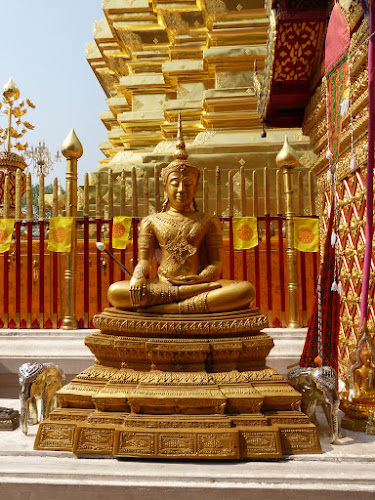The city of Chiang Mai, 700 km north of Bangkok, is a very old city with a rich cultural heritage. Nestled in the Ping River valley below some of the tallest mountinas in Thailand, the city was founded by King Mangrai as his "new capital" - Chiang Mai - in 1296.
With our guide, Mr. Chai (below), we were able to see and do a lot in our three days in the city. Chiang Mai has many temples and centers for monastic learning, as evidenced by the number of monks we saw walking about the city. Our touring was enriched with visits to some of the important temples and Chai's patient explanation of the basic tenets of Buddhism as practiced in this region of Thailand.
According to legend, "King Ku Na invited the venerable Sumana Thera, a very pious monk from Sukhothai to bring the Buddhism of Sri Lanka to Chiang Mai. The King offered him the royal flower garden (Suan Dok) as a place to build a temple. The temple was established in 1371. Wat Suan Temple is famous for its golden chedi which houses a relic of the Buddha.
The temple itself is very large and is used for royal ceremonies as well as everyday worship. The monk in this picture receives gifts from two young women. Chai suggested that they may be sisters who came on the date of a family occasion in remembrance of parents who have passed away. It is an opportunity to remember and receive a blessing. The gifts offered are practical things like detergent, shaving cream and razors. The monk receives them, but they are shared within the monastic community.
We travelled the mountain highway above the city to visit Wat Phrathat Doi Suthep. The steps led us to a golden temple complex filled with Sunday visitors. Legend has it that the relic of the Buddha that was honoured at the Flower Garden temple was divided in two and gifted by one king to another as a gesture of peace and brotherhood. The second relic was placed on the back of a white elephant. The elephant was let to roam and climb the mountain freely. The elephant died and where his body lay, the king ordered that a temple be built. In Thailand, there are apparently special ways to divine the sacred.
The holy site clearly belonged to the people. These monks were among the visitors and they were taking pictures of the same things we were.

This monk offered blessings to anyone who came to him.
The last temple we visited, Wat Chedi Luang, was our favorite. King Saen Muang Ma began building the chedi, according to the Chiang Mai online guide, "to enshrine the relics of his father at the end of the 14th century, but King Tilokarat completed it. The chedi used to be 90 meters high before it was partly destroyed in an earthquake in 1545; it was to remain the tallest structure in Chiang Mai for over 500 years. The present restored chedi is about 60 meters high." The second picture below shows a detail of the elephant statuary that would have surrounded the upper level of the chedi.
I liked the reclining Buddha resting in a beautifully painted temple off to the side.
As we listened to Mr. Chai's explanation of the life and teachings of Buddha, we agreed that there is wisdom to be found in the precepts of Buddhism. While there are many more temples in this ancient city, we had some other places to visit in our last days in Thailand. We did take time to photograph the restored moat that surrounds the old city and the ancient city walls that stand vigil today even as the tuk-tuks (motorcycle taxis) and cars of a busy modern city hurry by.














No comments:
Post a Comment